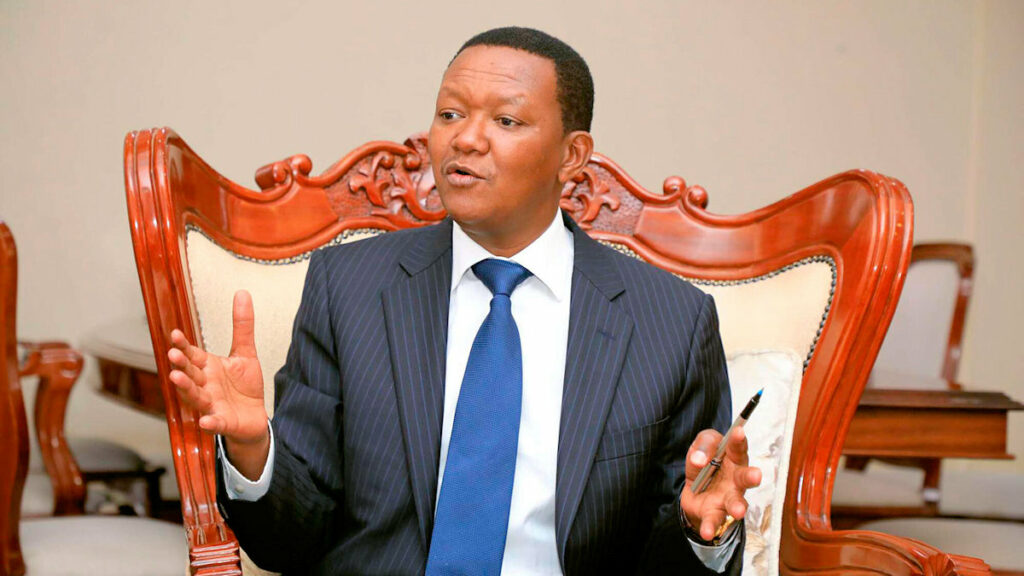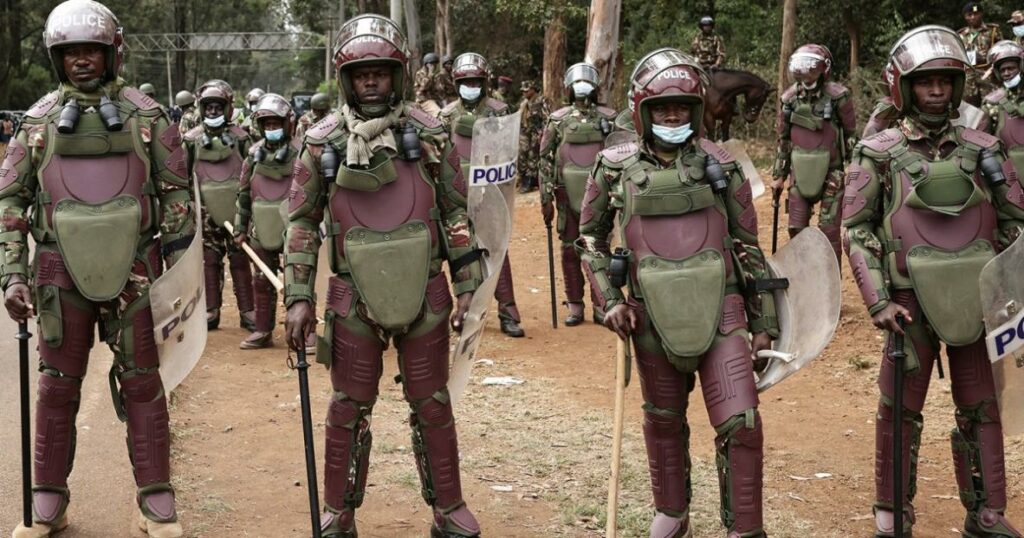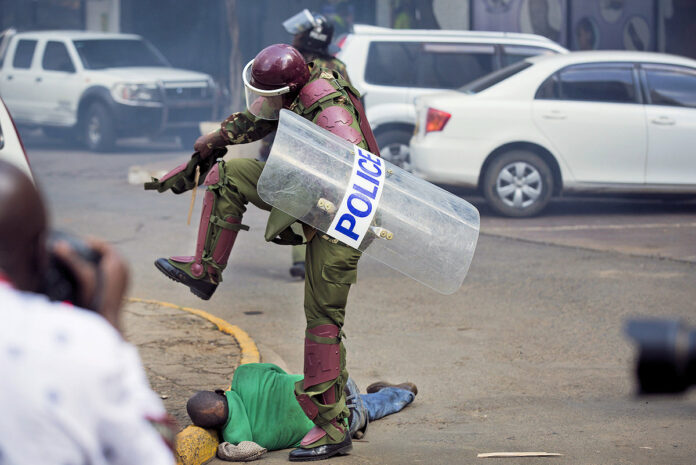(Français)
On Mon., Oct. 2, 2023, the UN Security Council passed Resolution 2699 authorizing a non-UN Multinational Security Support (MSS) force for Haiti. The resolution, adopted under UN Charter’s Chapter VII, was drafted by the United States and Ecuador. This Resolution represents the successful implementation of phase one Washington’s “10-Year Strategy for Haiti.” An U.S.-led invasion and 10 year occupation of Haiti is now imminent.
Phase two of the “10-Year Strategic Plan for Haiti” was implemented in the summer of 2023. Phase two seeks to build a network of at least 250 U.S.-funded “civil society” organizations to influence public policy and decision-making as Washington oversees the reconstruction of Haiti’s state institutions and government.
The consequences of Washington’s “10-Year Strategic Plan for Haiti” would be comparable to the 1915 American invasion and occupation of Haiti. If Washington gets its way, Haiti will turn from its current status as a U.S. neo-colony back into a virtual colony, as it was under U.S. Marine rule from 1915 to 1934.
Washington’s Global Fragility Act
Passed with full bipartisan support under President Donald Trump in 2019, the Global Fragility Act (GFA) was initially framed by proponents as an “an opportunity to drive the necessary change” to prevent “adversaries such as China and Russia to expand their influence.”
The U.S. government selected Haiti to be the first “partner” under the GFA. Also on the list are Libya, Mozambique, and Papua New Guinea, along with West Africa’s Benin, Côte d’Ivoire, Ghana, Guinea, and Togo.

The GFA follows the “2017 National Security Strategy” that will work to “strengthen” so-called “fragile states… where state weakness or failure would magnify threats to the American homeland.”
The GFA aims to prevent “fragile states” from developing diplomatic and trade relationships with Russia and China. In a 2021 speech, U.S. Secretary of State Antony Blinken described China as “the only country with the economic, diplomatic, military, and technological power to seriously challenge the stable and open international system – all the rules, values, and relationships that make the world work the way we want it to.”
This adversarial stance on China results from its rapprochement with “fragile states” which involves geo-strategic concerns, including access to raw materials.
In a major policy speech in Seoul in 2022, U.S. Treasury Secretary Janet Yellen explained that the U.S. “cannot allow countries like China to use their market position in key raw materials, technologies, or products to disrupt our economy and exercise unwanted geopolitical leverage.”
Haiti has mineral resources, primarily gold, valued at an estimated US$20 billion. It is unclear, however, whether these mineral resources can be extracted at a profit.
Washington also wants to prevent Haiti from developing closer diplomatic relations and economic ties with Russia. Jovenel Moïse, who was assassinated two years ago, established formal diplomatic relations with Moscow only one month before his assassination, accrediting Russian ambassador Sergey Melik-Bagdasarov. It was the first time Haiti had established diplomatic relations with Russia. Many argue that this could have been a factor which led Washington to green-light Moïse’s assassination.
Meanwhile, Haiti remains one of only 11 nations (not counting the Vatican) out of 193 worldwide which recognize Taiwan as an independent nation, the so-called “Republic of China.” The People’s Republic of China has sought to woo Haiti to drop Taiwan and formally establish diplomatic relations with it, just as the neighboring Dominican Republic did in 2018.

A “partnership” under the GFA between Haiti and Washington would ensure that Haiti remains under U.S. hegemony for decades. This would also block diplomacy and investment from countries like China. In 2017, China offered to overhaul Port-au-Prince’s crumbling infrastructure with a US$4.7 billion aid package if Haiti would recognize it and join its “One Belt, One Road Initiative.”
So far that hasn’t happened, and the GFA aims to keep things that way. It is a plan to maintain global hegemony and gather former colonies and neo-colonies under its wing.
It is no wonder that Washington chose Haiti as its first “partner” under the GFA. Haiti is often the laboratory where Washington tests its new imperialist strategies for maintaining hegemony.
Washington’s “10-Year Security Assistance” Program
The GFA emphasizes building relationships with “local civil society” by “strengthen[ing] the capacity of the United States to be an effective leader of international efforts to prevent extremism and violent conflict.”
This “capacity” also includes 10-year “planned security assistance.”
The U.S. government’s efforts to organize an armed intervention into Haiti over the past year are symbiotic with the GFA. Under the GFA, the U.S. government can negotiate “planned security assistance” with Haiti as part of a 10-year plan, but to do so, Washington wants a nominally elected government.
Blinken explained in a recent official statement that the GFA “underpins” a new strategy and provides an “ambitious framework for engaging creatively” with the United-States’ “global partners.” This new strategy is explained in a 2020 document titled “United States Strategy to Prevent Conflict and Promote Stability” (SPCPS), published by the State Department, Defense Department, USAID, and Treasury Department.
The SPCPS meets the GFA’s requirement for Washington’s “Global Fragility Strategy” and also outlines the its initial plan for providing 10-year “security-assistance” programs to its “partners.”
Washington wants to improve Haiti’s “governance of the security sector,” in addition to “professionaliz[ing] partner nation security forces, and build long-term relationships with key host nation security officials consistent with U.S. national security and economic interests.” (emphasis added).
In a follow-up document titled the “10-Year Strategic Plan for Haiti,” the U.S. outlined its intent to “integrate U.S. diplomacy, development, and security-sector engagement in Haiti.” In other words, the State Department, USAID, and the Pentagon – soft power and hard – will work together to implement the Global Fragility Strategy in Haiti.
Kenya is providing personnel for Phase one of Washington’s “10-Year Strategic Plan for Haiti” under the guise of providing support to the PNH. It’s the spearhead of the GFA “partnership” between Haiti and the U.S..
In a prepared statement to the House Committee on Foreign Affairs, Jim Saenz, Deputy Assistant Secretary Defense for Counternarcotics and Stabilization Policy, explained that the “DoD’s role in GFA implementation is to support the efforts of the Department of State as the lead, and the USAID as the lead implementer ” to “ensure that the 10-year plans …align the relevant goals, objectives, plans, and benchmarks with DoD policy.”
A key feature of Washington’s strategy is to intervene in Haiti’s affairs by directing USAID funds to Civil Society Organizations (CSOs) who are open to the U.S. government’s “market-based approaches” to “promoting stability” under a “partnership” imposed by a multinational armed force officially requested by Haiti’s current dictator, Dr. Ariel Henry.
The State Department Implements its 10-Year Strategic Plan for Haiti
The 10-year Strategic Plan for Haiti outlines the first two phases for the implementation of the Global Fragility Act in Haiti.
During Phase one, the U.S. government outlines a plan to “engage and leverage partners among Haitian civil society and the Haitian National Police (PNH) to inform and implement programming to strengthen citizen security and the rule of law.”
“Initial efforts will focus on key high-crime and high-violence neighborhoods and key transportation and economic hubs” the plan explains.
The UN Security Council’s (UNSC) approval of the one-year MSS non-UN mission to Haiti means Phase one is moving ahead.
This UNSC vote comes almost one year after Henry’s initial Oct. 6, 2022 request for “the immediate deployment of a specialized armed force, in sufficient quantity, to stop throughout the territory the humanitarian crisis caused by, among other things, the insecurity resulting from the criminal actions of armed gangs and their sponsors.”
Kenya is slated to lead the MSS, despite widespread popular and political resistance both in Kenya and Haiti, as well as internationally. Henry’s political rivals – the signatories to the Kingston Joint Declaration and the “January 30th Agreement” – are opposed to the MSS with Henry in power and insist that a transitional government must be put in place before the MSS enters Haiti.
A Kenyan press report explains that Kenya has said it will focus on guarding key infrastructure – ports, airports, and main roads. Le Nouvelliste, on the other hand, reported that Kenya will deploy a task force to combat armed gangs in Port-au-Prince.
Ecuador and several CARICOM countries have also pledged support and personnel for the Kenyan-led MSS, including Jamaica, the Bahamas, Barbados, and Antigua and Barbuda. The Miami Herald reported that Italy, Spain, Mongolia, Senegal, Belize, Suriname, Guatemala, and Peru have also offered support, although it is unclear what form this will take.
Speaking on Fri., Sep. 22 at the start of a UN meeting in New York, Antony Blinken said the United States would supply “robust financial and logistical assistance” to the MSS, promising US$200 million.
The MSS is an invasion of Haiti that could lead to a brutal 10 year occupation
In essence, Kenya is offering to provide personnel for Phase one of Washington’s 10-Year Strategic Plan for Haiti under the guise of providing security and support to the PNH. It is the spearhead of the GFA “partnership” between Haiti and the U.S..
“This proposed invasion is different from those of 1994 and 2004,” Kim Ives explained, “which involved bonafide UN blue-helmeted ‘peacekeepers’ under the control and oversight of the Security Council itself. The MSS’s unprecedented formula would be nominally overseen by Kenya, but actually by the U.S..”
Kenya provides the “Blackwashing” necessary for the U.S.-led invasion. This approach helps the UN avoid accountability as well. As Ben Norton explained, “It is a U.S. military intervention, using the UN and Kenya as cover.”
While the MSS’s purported purpose is to combat gangs, the primary goal is to facilitate a controlled changeover from Henry’s embattled regime to another transitional government also beholden to Washington.
Henry has been accused of playing a role in President Jovenel Moïse’s Jul. 7, 2021 assassination as well as backing some of Haiti’s most notorious criminal gangs. Henry was installed as PM by the U.S. government and its allied embassies, known as the “CORE Group,” via a short statement and tweet days after Moise’s assassination.
Since his selection, Henry has ruled without popular support or a single elected official in his government. He dutifully imposed U.S. policy in Haiti, allowing Haiti’s state institutions to crumble.
The UNSC only approved a one-year mandate for the MSS with renewal reviews after nine months. It is not surprising, however, that Kenyan Foreign Minister Alfred Mutua told the New York Times that their recent assessment “estimated that the project would take three years and require from 10,000 to 20,000 personnel.” He sanguinely explained that he “envisions some 50 more countries each pledging from 500 to 1,000 officers, so they can achieve the 20,000 or more needed.”
Jake Johnston commented on X (formerly Twitter), writing “MINUSTAH 2.0, the non-UN sequel?” The comparison is as obvious as it is ominous.
MINUSTAH is how the U.S. “outsourced its control of Haiti,” author and activist Bill Quigley explained. The UN force helped consolidate Washington’s post-2004-coup puppet prime minister Gérard Latortue and committed multiple crimes and massacres against the Haitian people. The force varied in size over the 13 years it was deployed in Haiti, averaging about 9,000 military troops and 4,000 police officers from 56 mostly poor countries.
MINUSTAH’s initial mandate was also for only six months, starting in 2004 following the coup against democratically elected President Jean-Bertrand Aristide. The mandate was extended several times. MINUSTAH occupied Haiti for 13 years – until 2017, where it was replaced by another Chapter VII armed force, MINUJUSTH.
Comprised at its peak of about 1,300 police officers, MINUJUSTH remained in Haiti for another two years, until 2019.
Mutua’s timeline of three years – triple the proposed one year MSS mission timeline – is surely an underestimate. Indeed, in a March 2023 interview, the International Crisis Group’s Renata Segura was pushed to explain how long the mission would take. She responded “probably years.”

Five months ago, while discussing a timeline for a multinational intervention force in Haiti, retired Canadian General Tom Lawson told CBC Radio that “we’re not talking a couple of years. We’re likely talking five to 10, 15 years, because we’re talking about nation-building. We’re not talking about establishing a safe and secure area for the government now to get to its tasks. We’re talking about a non-functioning government…And that’s in terms of – like we’ve seen in Afghanistan and Iraq – decades.”
Lawson’s comments underline that the MSS is an occupation force aiming to set the stage for the GFA’s “10 year security assistance” package.
Opposition emerges in Kenya itself
But the MSS is far from a done deal, despite the UNSC’s benediction. It hinges on Kenya’s leadership, and the Kenyan people may not put up with it.
On Oct. 5, Kim Ives tweeted that Kenyan parliamentarian Babu Owino believes there is a “102 percent” chance that Kenyan lawmakers will be able to prevent a deployment of 1,000 Kenyan police officers to Haiti, offering a ray of hope for Haiti. Owino shared his views during a Zoom conference with journalists and activists.
But Kenyan President William Ruto’s government can be expected to strike back. In July, Owino was arrested by Kenyan police and detained for three days for speaking out against police brutality.
This is a foreshadowing of the kind of violent oppression of dissent that will result from Kenyan forces occupying Port-au-Prince. Kenyan police have a “culture of internal impunity and criminality, and inadequate internal and external accountability,” explained Peter Kiama, the executive director of Kenya’s watchdog Independent Medico-Legal Unit. Kenyan police have also been accused of torture and shooting civilians.
As Owino predicted, the invasion plan has encountered pushback. On Oct. 9, the Kenyan High Court blocked Kenya’s deployment as part of the MSS in Haiti until Oct. 24, 2023, following a petition submitted by the Third Way Alliance political party.
Travis Ross is a teacher based in Montreal, Québec. He is also the co-editor of the Canada-Haiti Information Project at canada-haiti.ca . Travis has written for Haiti Liberté, Black Agenda Report, The Canada Files, TruthOut, and rabble.ca. He can be reached on Twitter











[…] published in Haïti Liberté. The first of two […]
[…] 22, Canada announced that it would contribute CAN$80.5 million (US$59.4 million) to the nominally Kenyan-led Multinational Security Support mission (MSS) to Haiti. (The U.S. has pledged $200 million, while the overall price tag will be about $620 […]
[…] lead this third invasion called the “Multinational Security Support Mission” (MSS), sanctified by UN Security Council Resolution 2699. Everyone knows, however, that Washington would be calling the […]